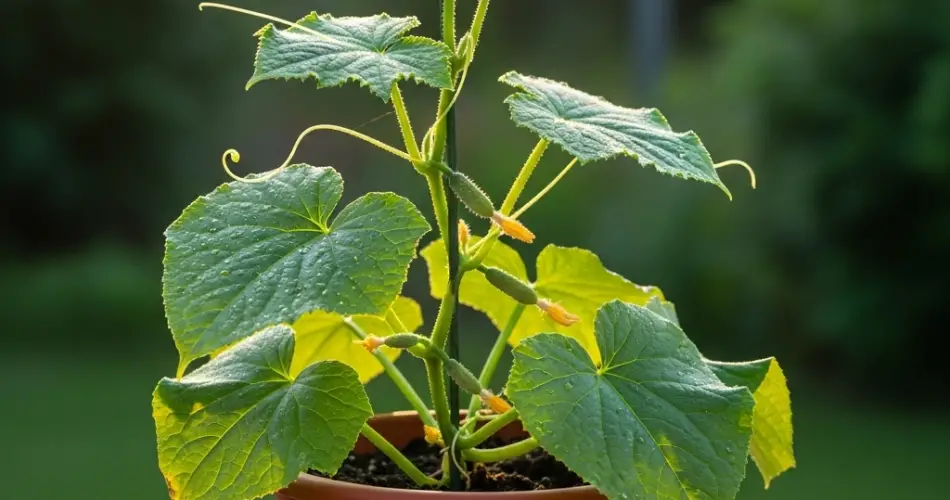Growing cucumbers in containers is a great way to enjoy this refreshing vegetable even if you don’t have a large garden. Whether you want to slice them into salads or pickle them for later use, cucumbers grow well in pots with the right care and setup. With just a few simple tools and steps, you can go from seed to snack—all from the convenience of your balcony, patio, or porch.
Why Grow Cucumbers in Pots?
Cucumbers are ideal for container gardening because they grow quickly and don’t require deep soil. They are also well-suited for vertical growing, making them a perfect match for gardeners with limited space. Container gardening offers better control over soil quality, sunlight, watering, and pests, making your cucumber crop easier to manage and more productive.
Choosing the Right Cucumber Variety
Not all cucumbers perform well in containers. It’s best to select compact or bush varieties. These are bred to grow in small spaces and often have shorter vines and higher yields. Recommended varieties include:
-
Bush Pickle – Compact and ideal for pickling.
-
Spacemaster – Perfect for small containers.
-
Patio Snacker – Great flavor and suited for vertical growth.
-
Salad Bush – Crisp and refreshing, excellent for fresh eating.
These types are easier to manage and won’t overwhelm your pot or trellis system.
Preparing Your Container
Cucumbers need plenty of root space, so choose a pot that’s at least 12–14 inches deep and 12–16 inches wide. Drainage holes are essential to prevent root rot, so be sure your container allows excess water to escape.
Materials like food-grade plastic, ceramic, or cloth grow bags all work well. Plastic containers are lightweight and hold moisture efficiently, while grow bags offer excellent aeration.
Soil and Fertilizer
A high-quality, well-draining potting mix is key to healthy cucumber plants. Avoid using garden soil, which can compact and introduce pests or diseases.
Create a nutrient-rich mix with:
-
2 parts potting soil
-
1 part compost or worm castings
-
1 part perlite or vermiculite for aeration
Mix in a slow-release organic fertilizer at planting time. Cucumbers are heavy feeders, so supplement with a balanced liquid fertilizer (10-10-10 or similar) every two weeks throughout the growing season. Once the plants flower, you can switch to a fertilizer higher in potassium and phosphorus to encourage fruiting.
Planting Your Cucumbers
Start seeds directly in your container or transplant seedlings after the last frost. If planting seeds, sow 2–3 seeds per container about 1 inch deep. Once the seedlings sprout, thin them down to one strong plant per pot.
Cucumbers love warmth and sunshine, so place your container in a spot that receives 6–8 hours of direct sunlight daily. A south-facing balcony or sunny wall works well.
Watering and Mulching
Cucumbers need consistent moisture to grow well. Dry soil can lead to bitter fruit or blossom end rot. Water when the top inch of soil feels dry, and ensure the pot drains thoroughly.
To help retain moisture and reduce evaporation, add a 1–2 inch layer of mulch such as straw, dried leaves, or shredded bark on top of the soil. Mulch also helps regulate soil temperature and reduces weed growth.
Supporting the Vines
While bush varieties stay compact, vining cucumbers benefit from vertical support. A small trellis, cage, or stakes will guide the plant upward, saving space and keeping fruit clean. Vertical growing also improves air circulation, reducing the risk of fungal diseases.
Tie vines loosely to supports as they grow, and gently guide them to climb upward.
Pollination and Fruit Development
Cucumbers have male and female flowers, and bees or other insects usually handle pollination. If growing indoors or in an area with few pollinators, you may need to hand-pollinate. Use a small brush or cotton swab to transfer pollen from the male to the female flowers.
You’ll know female flowers by the small swelling at the base, which becomes the fruit after successful pollination.
Harvesting Cucumbers
Cucumbers grow fast once fruiting begins. Check your plants daily and harvest when fruits are firm, evenly colored, and reach the desired size for your chosen variety. Don’t wait too long—overripe cucumbers can become seedy or bitter and reduce overall production.
Frequent harvesting encourages the plant to produce more fruit.
From Harvest to Pickles
If you’re growing pickling cucumbers, rinse and refrigerate them immediately after harvest. You can turn them into pickles using a basic vinegar brine, garlic, and dill. Fresh cucumbers can also be stored in the fridge for up to a week.
Making your own pickles is easy and satisfying. Simply pack sliced or whole cucumbers into jars with herbs and garlic, pour in the brine, and refrigerate for a few days before enjoying.
Final Thoughts
Container gardening allows you to grow cucumbers successfully in small spaces while keeping everything manageable and close at hand. With a sunny spot, the right pot and soil, and a little care, you can enjoy crisp cucumbers straight from your container garden—fresh or pickled. Whether you’re adding them to salads or bottling them for later, container cucumbers are a smart, space-saving crop for any home gardener.



